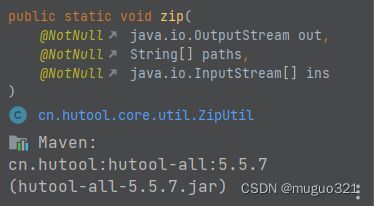java 批量下载将多个文件(minio中存储)压缩成一个zip包
我的需求是将minio中存储的文件按照查询条件查询出来统一压成一个zip包然后下载下来。
思路:针对这个需求,其实可以有多个思路,不过也大同小异,一般都是后端返回流文件前端再处理下载,也有少数是压缩成zip包之后直接给下载链接返回到前端,前端收到链接url直接window.open()进行下载,不过这种下载zip包的路径要确保是在网站下,否则访问不到,还有一个缺点就是文件没法删除,占用存储空间,后期需人为动作清理,选择哪种思路就可以看具体需求啦,我选择的是第一种思路,以下就针对第一种后端返回流方式进行具体介绍。
首先说第一种方法:将需要下载的文件找到,minio中有查询方法将文件转成inputStream,这里就不多说了,拿到一组InputStream,我们就可以写入一个zip包里了,创建临时zip路径,将流遍历写入文件,读取临时zip文件再写入response中的outputStream,最后删除临时文件。
前端处理方法最后统一介绍,后端核心代码如下:
public void downloadZip(String name, List filePaths,HttpServletResponse response){
File zipFile = compressedFileToZip(name,filePaths);
ByteArrayOutputStream os = new ByteArrayOutputStream();
try {
FileInputStream ins = new FileInputStream(zipFile);
WritableByteChannel writableByteChannel = Channels.newChannel(os);
FileChannel fileChannel = ins.getChannel();
fileChannel.transferTo(0, fileChannel.size(), writableByteChannel);
fileChannel.close();
response.setCharacterEncoding("UTF-8");
name = URLEncoder.encode(name, "UTF-8");
response.setContentType("application/octet-stream");
response.addHeader("Content-Disposition", "attachment;filename=" + new String(name.getBytes("iso8859-1")));
response.setContentLength(os.size());
response.setHeader("filename", name);
response.addHeader("Content-Length", "" + os.size());
var outputstream = response.getOutputStream();
os.writeTo(outputstream);
os.flush();
os.close();
outputstream.flush();
outputstream.close();
writableByteChannel.close();
if(zipFile.exists()){
//删除临时文件
zipFile.delete();
}
} catch (IOException e) {
e.printStackTrace();
} finally {
try {
os.close();
} catch (IOException e) {
e.printStackTrace();
}
}
}
/**
* 构建临时zip文件
**/
public File compressedFileToZip(String name, List mediaFileEntityList) {
String zipName = name.concat(LocalDateTime.now().format(DateTimeFormatter.ofPattern("yyyyMMddHHmmss"))).concat(".zip");
//临时zip路径
String fileZipPath = System.getProperty("user.dir").concat("/").concat(zipName);
OutputStream os = null;
ZipOutputStream zos = null;
File file = new File(fileZipPath);
try {
if(!file.exists()){
file.createNewFile();
}
os= new FileOutputStream(file);
zos = new ZipOutputStream(os) ;
for (MediaFileEntity entity:mediaFileEntityList
) {
zos.putNextEntry(new ZipEntry(entity.getFileName()));
//minio 获取流
InputStream ins = ossService.getObject(OssConfiguration.bucket,entity.getObjectKey());
FileInputStream insf=convertToFileInputStream(ins);
WritableByteChannel writableByteChannel = Channels.newChannel(zos);
FileChannel fileChannel = insf.getChannel();
fileChannel.transferTo(0, fileChannel.size(), writableByteChannel);
zos.closeEntry();
fileChannel.close();
ins.close();
}
} catch (IOException e) {
e.printStackTrace();
}finally {
if(zos != null){
try {
zos.close();
} catch (IOException e) {
e.printStackTrace();
}
}
if(os != null){
try {
os.close();
} catch (IOException e) {
e.printStackTrace();
}
}
}
return file;
} 第二种方法:安装hutool依赖,调用hutool包中的ZipUtil工具类中的zip方法进行下载,。此方法需要有3个参数,分别是OutoutStream,每个流对应的文件名字符串数组,文件的InputStream数组。
首先将需要下载的文件找到,拿到一组InputStream,也就是zip方法中的第3个参数,第一个参数顾名思义就是你想要输出的地方,我们是返回给前端所以就是response.getOutputStream(),第二个参数我们遍历文件时也可以拿到,废话不多说了,上代码看吧。
在项目下安装hutool依赖
cn.hutool hutool-all 5.5.7
/**
* 下载多个文件转zip压缩包
*
* @param mediaFileEntityList
* @param response
* @throws Exception
*/
public void dowloadToZip(List mediaFileEntityList, HttpServletResponse response) throws Exception {
int i = 0;
//如果有附件 进行zip处理
if (mediaFileEntityList != null && mediaFileEntityList.size() > 0) {
try {
//被压缩文件流集合
InputStream[] srcFiles = new InputStream[mediaFileEntityList.size()];
//被压缩文件名称
String[] srcFileNames = new String[mediaFileEntityList.size()];
for (MediaFileEntity entity : mediaFileEntityList) {
//以下代码为获取图片inputStream
InputStream ins = ossService.getObject(OssConfiguration.bucket,entity.getObjectKey());
if (ins == null) {
continue;
}
//塞入流数组中
srcFiles[i] = ins;
srcFileNames[i] = entity.getFileName();
i++;
}
response.setCharacterEncoding("UTF-8");
response.setHeader("Content-Disposition", "attachment;filename=" + URLEncoder.encode("下载.zip", "UTF-8"));
//多个文件压缩成压缩包返回
ZipUtil.zip(response.getOutputStream(), srcFileNames, srcFiles);
} catch (IOException e) {
e.printStackTrace();
}
}
} Controller这边可以直接写成没有返回值的接口,我的例子如下,仅供参考:
@GetMapping("/{workspace_id}/fileDownList")
@ApiOperation(value = "查询文件的下载地址")
public void getFileStreamList(@PathVariable(name = "workspace_id") String workspaceId,
@RequestParam(name = "ids") String ids, HttpServletResponse response) throws Exception {
List fileIds= Arrays.stream(ids.split(",")).collect(Collectors.toList()).stream()
.map(Integer::parseInt)
.collect(Collectors.toList());
List mediaFileEntityList = fileService.getMediaListById(workspaceId, fileIds);
// fileUtil.downloadZip("111",mediaFileEntityList,response);//第一种方法
fileUtil.dowloadToZip(mediaFileEntityList,response);//第二种方法
} 到此,后端zip下载就完毕了,下面我们说说前端如何处理
网上查询前端处理大致都是如下,但是我自己使用的时候下载总是提示损坏,后找了一个工具类直接调用,就可以了,示例代码请求是get,如需调整,可根据情况自行调整
核心代码如下:
import { saveAs } from 'file-saver';
const baseURL = (window as any).config.VITE_APP_BASE_API; //import.meta.env.VITE_APP_BASE_API;
export default {
zip(url: string, name: string) {
url = baseURL + url;
axios({
method: 'get',
url: url,
responseType: 'blob',
headers: { Authorization: 'Bearer ' + getToken() },
}).then(res => {
const isBlob = blobValidate(res.data);
if (isBlob) {
const blob = new Blob([res.data], { type: 'application/zip' });
this.saveAs(blob, name);
} else {
this.printErrMsg(res.data);
}
});
},
saveAs(text: any, name: string, opts?: any) {
saveAs(text, name, opts);
},
async printErrMsg(data: any) {
const resText = await data.text();
const rspObj = JSON.parse(resText);
const errMsg = errorCode[rspObj.code] || rspObj.msg || errorCode['default'];
// ElMessage.error(errMsg);
},
blobValidate(data: any) {
return data.type !== 'application/json';
}
};按钮绑定方法直接调用zip下载方法,传参为url和要导出zip的名称,示例如下:
import download from '@/plugins/download';
function batchDownload(){
ElMessage.success("文件下载中,请勿重复点击!");
download.zip(`/media/api/v1/files/${workspaceId}/fileDownList?ids=${selectlist.value.join(",")}`,"MediaFiles"+new Date().toLocaleDateString()+".zip")
}